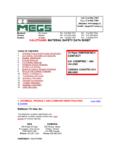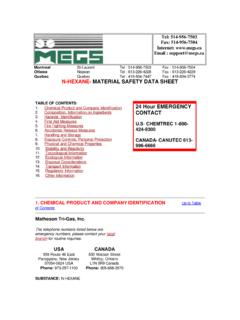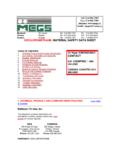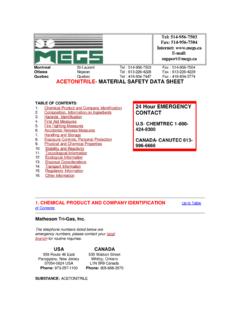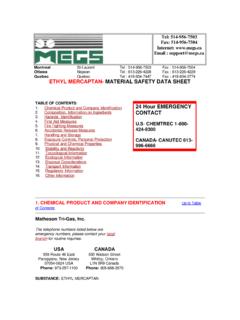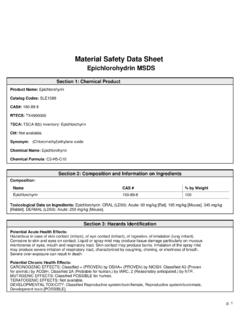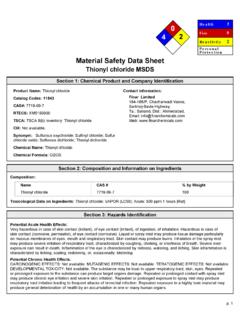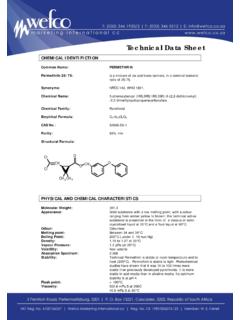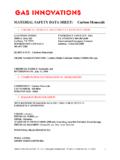Transcription of CHLOROBENZENE- MATERIAL SAFETY DATA SHEET
1 Tel: 514-956-7503. Fax: 514-956-7504. Internet: Email : Montreal St-Laurent Tel : 514-956-7503 Fax : 514-956-7504. Ottawa Nepean Tel : 613-226-4228 Fax : 613-226-4229. Quebec Quebec Tel : 418-834-7447 Fax : 418-834-3774. chlorobenzene - MATERIAL SAFETY data SHEET . TABLE OF CONTENTS: 1. Chemical Product and Company Identification 24 Hour EMERGENCY. 2. Composition, Information on Ingredients CONTACT. 3. Hazards Identification 4. First Aid Measures 5. Fire Fighting Measures CHEMTREC 1-800- 6. Accidental Release Measures 424-9300. 7. Handling and Storage 8. Exposure Controls, Personal Protection CANADA- CANUTEC 613- 9. Physical and Chemical Properties 996-6666. 10. Stability and Reactivity 11. Toxicological Information 12.
2 Ecological Information 13. Disposal Considerations 14. Transport Information 15. Regulatory Information 16. Other Information 1. CHEMICAL PRODUCT AND COMPANY IDENTIFICATION-----------Up to Table of Contents Matheson Tri-Gas, Inc. The telephone numbers listed below are emergency numbers, please contact your local branch for routine inquiries. USA CANADA. 959 Route 46 East 530 Watson Street Parsippany, New Jersey Whitby, Ontario 07054-0624 USA L1N 5R9 Canada Phone: 973-257-1100 Phone: 905-668-3570. SUBSTANCE: chlorobenzene . SYMBOL: C6H5Cl TRADE NAMES/SYNONYMS: PHENYL CHLORIDE; MONOCHLOROBENZENE; CP 27; CARRIER T 40; MCB; TETROSIR. SP; U037; STCC 4909153; UN 1134; MONOCHLOROBENZOL; BENZENE CHLORIDE; B-224.
3 B-255; BBENZENE, CHLORO; MAT04730; RTECS CZ0175000. CHEMICAL FAMILY: halogenated, aromatic CREATION DATE: Jan 24 1989. REVISION DATE: Mar 16 1999. 2. COMPOSITION, INFORMATION ON INGREDIENTS-----------Up to Table of Contents COMPONENT: chlorobenzene . CAS NUMBER: 108-90-7. EC NUMBER (EINECS): 203-628-5. EC INDEX NUMBER: 602-033-00-1. PERCENTAGE: 3. HAZARDS IDENTIFICATION-----------Up to Table of Contents NFPA RATINGS (SCALE 0-4): HEALTH=3 FIRE=3 REACTIVITY=0. WHMIS CLASSIFICATION: BD2. EC CLASSIFICATION (ASSIGNED): Flammable Xn Harmful N Dangerous for the Environment R 10-20-51/53. EC Classification may be inconsistent with independently-researched data . EMERGENCY OVERVIEW: Color: colorless Physical Form: liquid Odor: almond odor Major Health Hazards: harmful if inhaled, respiratory tract irritation, skin irritation, eye irritation, central nervous system depression Physical Hazards: Flammable liquid and vapor.
4 Vapor may cause flash fire. POTENTIAL HEALTH EFFECTS: INHALATION: Short Term Exposure: irritation, headache, drowsiness, symptoms of drunkenness, bluish skin color, coma Long Term Exposure: tingling sensation, liver damage SKIN CONTACT: Short Term Exposure: irritation, rash Long Term Exposure: burns EYE CONTACT: Short Term Exposure: irritation Long Term Exposure: same as effects reported in short term exposure INGESTION: Short Term Exposure: nausea, vomiting, stomach pain, headache, symptoms of drunkenness, bluish skin color, coma Long Term Exposure: liver damage CARCINOGEN STATUS: OSHA: N. NTP: N. IARC: N. 4. FIRST AID MEASURES-----------Up to Table of Contents INHALATION: Remove from exposure immediately.
5 Use a bag valve mask or similar device to perform artificial respiration (rescue breathing) if needed. Get medical attention. SKIN CONTACT: Remove contaminated clothing, jewelry, and shoes immediately. Wash with soap or mild detergent and large amounts of water until no evidence of chemical remains (at least 15-20. minutes). Get medical attention, if needed. EYE CONTACT: Wash eyes immediately with large amounts of water or normal saline, occasionally lifting upper and lower lids, until no evidence of chemical remains. Get medical attention immediately. INGESTION: If vomiting occurs, keep head lower than hips to help prevent aspiration. If person is unconscious, turn head to side. Get medical attention immediately.
6 NOTE TO PHYSICIAN: For ingestion, consider gastric lavage. Consider oxygen. 5. FIRE FIGHTING MEASURES-----------Up to Table of Contents FIRE AND EXPLOSION HAZARDS: Severe fire hazard. Moderate explosion hazard. Vapor/air mixtures are explosive above flash point. The vapor is heavier than air. Vapors or gases may ignite at distant ignition sources and flash back. EXTINGUISHING MEDIA: regular dry chemical, carbon dioxide, water, regular foam Large fires: Use regular foam or flood with fine water spray. FIRE FIGHTING: Move container from fire area if it can be done without risk. Cool containers with water spray until well after the fire is out. Stay away from the ends of tanks. For fires in cargo or storage area: Cool containers with water from unmanned hose holder or monitor nozzles until well after fire is out.
7 If this is impossible then take the following precautions: Keep unnecessary people away, isolate hazard area and deny entry. Let the fire burn. Withdraw immediately in case of rising sound from venting SAFETY device or any discoloration of tanks due to fire. For tank, rail car or tank truck: Evacuation radius: 800 meters (1/2 mile). Do not attempt to extinguish fire unless flow of MATERIAL can be stopped first. Flood with fine water spray. Do not scatter spilled MATERIAL with high- pressure water streams. Cool containers with water spray until well after the fire is out. Apply water from a protected location or from a safe distance. Avoid inhalation of MATERIAL or combustion by-products. Stay upwind and keep out of low areas.
8 Water may be ineffective. FLASH POINT: 82 F (28 C) (CC). LOWER FLAMMABLE LIMIT: UPPER FLAMMABLE LIMIT: AUTOIGNITION: 1099 F (593 C). FLAMMABILITY CLASS (OSHA): IC. 6. ACCIDENTAL RELEASE MEASURES-----------Up to Table of Contents AIR RELEASE: Reduce vapors with water spray. SOIL RELEASE: Trap spilled MATERIAL at bottom in deep water pockets, excavated holding areas or within sand bag barriers. Dike for later disposal. Absorb with sand or other non-combustible MATERIAL . Collect with absorbent into suitable container. WATER RELEASE: Absorb with activated carbon. Remove trapped MATERIAL with suction hoses. Collect spilled MATERIAL using mechanical equipment. OCCUPATIONAL RELEASE: Avoid heat, flames, sparks and other sources of ignition.
9 Stop leak if possible without personal risk. Reduce vapors with water spray. Small spills: Absorb with sand or other non-combustible MATERIAL . Collect spilled MATERIAL in appropriate container for disposal. Large spills: Dike for later disposal. Remove sources of ignition. Keep unnecessary people away, isolate hazard area and deny entry. Reportable Quantity (RQ): Notify Local Emergency Planning Committee and State Emergency Response Commission for release greater than or equal to RQ ( SARA Section 304). If release occurs in the and is reportable under CERCLA Section 103, notify the National Response Center at (800)424-8802 (USA) or (202)426-2675 (USA). 7. HANDLING AND STORAGE-----------Up to Table of Contents Store and handle in accordance with all current regulations and standards.
10 Subject to storage regulations: OSHA 29 CFR Grounding and bonding required. Store with flammable liquids. Store outside or in a detached building. Keep separated from incompatible substances. Keep separated from incompatible substances. 8. EXPOSURE CONTROLS, PERSONAL PROTECTION-----------Up to Table of Contents EXPOSURE LIMITS: chlorobenzene : 75 ppm (350 mg/m3) OSHA TWA. 10 ppm (46 mg/m3) ACGIH TWA. VENTILATION: Provide local exhaust ventilation system. Ventilation equipment should be explosion-resistant if explosive concentrations of MATERIAL are present. Ensure compliance with applicable exposure limits. EYE PROTECTION: Wear splash resistant SAFETY goggles. Provide an emergency eye wash fountain and quick drench shower in the immediate work area.
